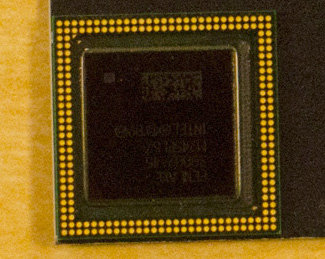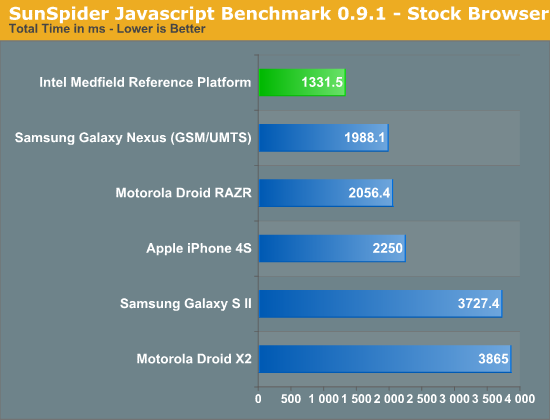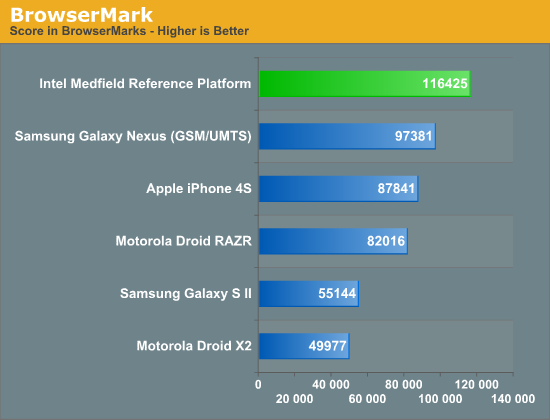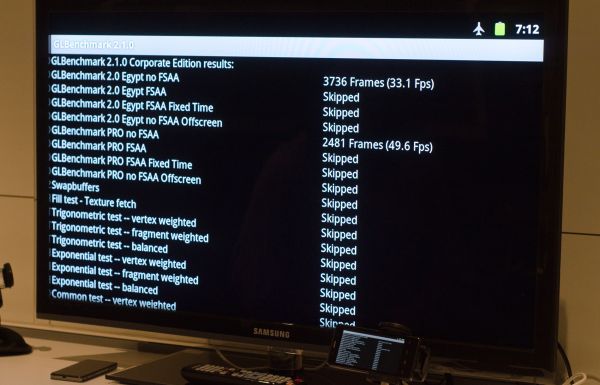Intel's Medfield & Atom Z2460 Arrive for Smartphones: It's Finally Here
by Anand Lal Shimpi on January 10, 2012 8:00 PM ESTIt's here. Intel's first smartphone SoC that you'll actually be able to buy in a device before the end of the year. The platform is called Medfield and Paul Otellini just announced its first device partners.
Medfield starts out as a bonafide mobile SoC. Whereas Moorestown was a "two-chip" solution, Medfield is just one - the Penwell SoC:

The SoC is only available in a PoP (Package on Package) configuration measuring 12mm x 12mm. Intel wouldn't give out a die size but it did show me a Penwell sample without the stacked DRAM:

Since I know the measurements of the package I could estimate the dimensions of the silicon itself. My math worked out to be around 62mm^2. That's larger than a Tegra 2-class SoC, but smaller than Tegra 3 or Apple's A5. The diagram of its high level architecture above helps explain why.
There's only a single version of Medfield being announced today: the Intel Atom Z2460. The Z2460 features a single Atom core with a 512KB L2 cache, a PowerVR SGX 540 GPU and a dual-channel LPDDR2 memory interface. In a world where talking about four Cortex A9s and PowerVR SGX 544MP2s isn't uncommon, Medfield starts out almost sounding a bit...tame. But then you see its performance:

Although running what appears to be a stock Gingerbread browser, Intel's Medfield reference platform posts SunSpider performance better than any other smartphone we've tested - including the Galaxy Nexus running Ice Cream Sandwich. Intel promises that Medfield's performance will scale on ICS as well - the gap should be maintained. We've seen high results from reference designs in the past, but the Medfield platform is a little different as you'll soon see - it's a complete smartphone design that should be representative of handsets that hit the market later this year.
Medfield isn't a one trick pony either, performance is similarly dominating under BrowserMark:

These are tablet-like scores. Here the Galaxy Nexus running ICS comes close, but once again Intel expects that on the same OS Medfield should be faster than any of the currently available SoCs.
I asked Intel where its SunSpider and BrowserMark performance advantages came from, especially considering we've typically only seen huge gains with new browsers and not new SoCs. Their response pointed to a bunch of factors, but one stand out issue was the A9 has a great execution core but seems to be more limited on the memory interface. Atom can support far more outstanding misses in L2 than the Cortex A9, which chokes bandwidth to the processor for anything not already in the L2 cache. This may be one of the reasons why we've never been able to get really high bandwidth numbers out of A9 based SoCs. It's probably safe to assume that things will be different with the Cortex A15, but for now it's little things like this that give Medfield a performance advantage.
GPU performance is understandably not as impressive. We couldn't get offscreen numbers of GLBenchmark 2.1 but we did get results at the device's native resolution (1024 x 600):
3D performance is better than the OMAP 4460 due to Medfield's 400MHz GPU clock compared to ~300MHz in most OMAP4 devices.
Performance without power considerations is meaningless, especially in the smartphone world. Luckily for Intel, Medfield seems very competitive there as well. Intel provided some power and performance data for Medfield based on its reference platform. I still haven't been able to verify any of this for myself, but I was able to see some power tests run in person on the reference platform and competitive devices.
The Intel provided values are pretty astonishing . Sub 20mW idle, sub 750mW during a call on 3G and although not pictured here, Intel's internal data suggests ~1W power consumption while browsing the web compared to ~1.3W on the iPhone 4S and Galaxy S 2. I've done my own measurements on 4S web browsing and came up with a very similar value.
| Intel Measured Smartphone Power Consumption (Identical Display Brightness) | ||||||
| Standby (3G) | Talk (3G) | Browsing (3G) | Video Playback 720p | |||
| Apple iPhone 4S | ~38mW | ~800mW | ~1.3W | ~500mW | ||
| Intel Medfield Reference | ~18mW | ~700mW | ~1.0W | ~850mW | ||
| Samsung Galaxy S II | ~19mW | ~675mW | ~1.2W | ~650mW | ||
The performance and power data both look great for Medfield. You would think that this data, assuming there's nothing fundamentally wrong, would be enough to convince a handset maker to actually give Intel a shot. You'd be right.
In addition to disclosing Medfield performance data, Intel is also announcing partnerships with both Motorola and Lenovo. The former is a broad, multi-year agreement stating that Motorola plans on creating many devices based on Intel silicon - the first of which will be a smartphone due out before the end of the year. Tablets will follow at some point as well.
Lenovo on the other hand will actually be taking and tweaking Intel's own Medfield reference platform, and releasing it in China in Q2.
All of this is exactly what Intel needed: a start.











164 Comments
View All Comments
Hector2 - Wednesday, January 11, 2012 - link
So you doubt Anand's power measurements too ?As for the DX11 demo, Intel's VP showed very poor judgement running a video when they had trouble getting the demo out in time -- that's a major screw up, but Anand showed that the hardware actually works in spite of the screwed up demo.
french toast - Thursday, January 12, 2012 - link
No i dont doubt Anands Integrity or his benchmarks, i have just questioned his optimistic assuptions on un proven Intel hardware, especially when Intel produced the scope and the power benchmarks.All of which compare last years hardware, all the Intel sorced benches are single threaded and are likely due to Intel software optimisations, and lastly because the atom is higher clocked.
The benches as exophase has pointed out are on things that the cpu is not loaded/stressed.
Its great he has provided us with an insight, but this in no way proves that this architecture is the best nor does it prove that it would have 'dominated' android devices last year for a whole number of reasons that i cant be bothered to re-type.
Anand has jumped the gun on his conclusions thats all im saying
Dark_Archonis - Tuesday, January 10, 2012 - link
Time for the haters to eat their words, and the ARM supporters to admit they were wrong.On the forums there were enough self-proclaimed "experts" that claimed Intel was doomed and that ARM would take over. Well who's laughing now? Here we see an Atom SoC, that has power characteristics EQUAL or BETTER THAN ARM SoCs, while posting very strong performance as well. This is keeping in mind that it is just the first step for Intel in the smartphone market.
ARM supporters are already claiming that Medfield only looks good because it's being compared to year-old ARM designs. But guess what, the Atom design is 5 years old! Yes, this is a new SoC for Intel, but the fact is Intel must be given HUGE credit that they were able to make an SoC based on the 5-year old Atom design that is extremely competitive in power and performance to ARM SoCs.
Next-gen ARM designs will arrive later this year yes, but Intel will not stand still either. Also lets not forget about the next-gen Atom that will come in 2013 on the 22nm process. That will be a HUGE leap forward for Intel and will put them in an extremely competitive position against any quad-core ARM SoCs.
DigitalFreak - Tuesday, January 10, 2012 - link
You want a cookie or something? No-one cares about your fanboy rant.Dark_Archonis - Tuesday, January 10, 2012 - link
Obviously you cared enough to login, and make a useless, childish post devoid of anything meaningful, instead of actually replying to what I had posted.Great job at proving yourself wrong.
name99 - Wednesday, January 11, 2012 - link
Dude, the reason he is (justifiably) mocking you is that you are comparing ARM silicon that is shipping TODAY with Intel silicon that will be shipping in a YEAR.That's how it works among adults --- you compare shipping with shipping, not what I plan to ship (one day) with what you plan to ship (one day).
guilmon19 - Tuesday, January 10, 2012 - link
Except that Medfield is built on a 32nm process while ALL available A9s out there are built on the 45nm process. If the A9's were 32nm as well these benchmarks would be very different and these benchmarks came straight from intel, lets way wait till we actually get the phone and do benchmarks from there to determine which one is better.madmilk - Tuesday, January 10, 2012 - link
Doesn't matter than Medfield is 32nm, by the time anyone else makes a 32nm SoC Intel will be on 22nm.It's a massive advantage that can't just be thrown away, especially if trying to make a fair comparison.
Exophase - Tuesday, January 10, 2012 - link
Hardly, TSMC 28nm ARM processors are right around the corner while 22nm Atoms won't hit until 2013. Intel's doesn't yet have the same process advantage with their LP SoC nodes.Dark_Archonis - Tuesday, January 10, 2012 - link
Your point being? Even looking at TSMC's 28nm process, Intel will still have quite an advantage with their 22nm process. ARM will only have an advantage for a few quarters with the 28nm process, then Intel will come out with their 22nm process. You also fail to acknowledge that Atom on 22nm (Silvermont) will a brand new Atom architecture, which you can bet will be a HUGE leap forward in performance and power efficiency.TSMC is well known for having lots of trouble moving to new a process. Exophase, you should rephrase "right around the corner" to say in 1-2 quarters at the very least. It will still be a few months before we see any 28nm ARM phones actually on the market.
Intel has aligned their mobile and desktop process roadmaps, so all future Atoms will move to a new process node as fast as Intel's desktop chips.
Intel will also have a technological advantage as their 22nm process introduces FinFET, while TSMC won't have FinFET until their 14nm process.
Furthermore, Intel intends to introduce 14nm in 2013/2014, while TSMC won't introduce 14nm until 2015.
Intel was really slow getting into the smartphone market, but now that they have their foot in the door, they will not let off the gas. Intel's efforts in the smartphone market will only accelerate from this point. Intel will attack ARM directly at the low-end power scale in this case, and ARM will struggle greatly at the high end as Intel's Haswell will offer revolutionary power/performance ratios. That's not even mentioning what power/performance ratios we will see from the the next-gen Atom design.
Also let me restate that this is Intel's *first step* into the smartphone market, and they are able to be very competitive with ARM designs.